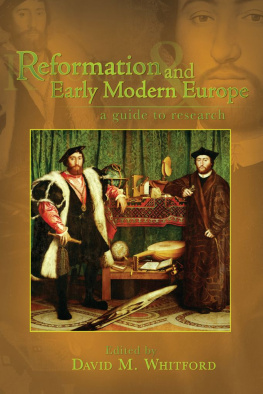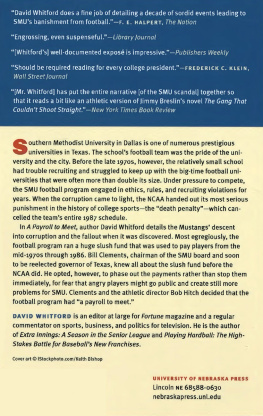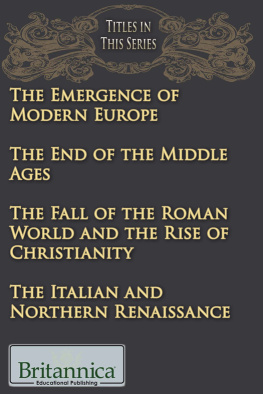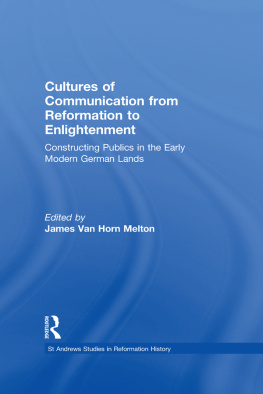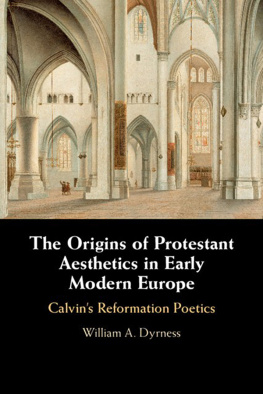David M. Whitford - Reformation and Early Modern Europe: A Guide to Research
Here you can read online David M. Whitford - Reformation and Early Modern Europe: A Guide to Research full text of the book (entire story) in english for free. Download pdf and epub, get meaning, cover and reviews about this ebook. year: 2007, publisher: PennStateUP, genre: Religion. Description of the work, (preface) as well as reviews are available. Best literature library LitArk.com created for fans of good reading and offers a wide selection of genres:
Romance novel
Science fiction
Adventure
Detective
Science
History
Home and family
Prose
Art
Politics
Computer
Non-fiction
Religion
Business
Children
Humor
Choose a favorite category and find really read worthwhile books. Enjoy immersion in the world of imagination, feel the emotions of the characters or learn something new for yourself, make an fascinating discovery.
- Book:Reformation and Early Modern Europe: A Guide to Research
- Author:
- Publisher:PennStateUP
- Genre:
- Year:2007
- Rating:4 / 5
- Favourites:Add to favourites
- Your mark:
- 80
- 1
- 2
- 3
- 4
- 5
Reformation and Early Modern Europe: A Guide to Research: summary, description and annotation
We offer to read an annotation, description, summary or preface (depends on what the author of the book "Reformation and Early Modern Europe: A Guide to Research" wrote himself). If you haven't found the necessary information about the book — write in the comments, we will try to find it.
Reformation and Early Modern Europe: A Guide to Research — read online for free the complete book (whole text) full work
Below is the text of the book, divided by pages. System saving the place of the last page read, allows you to conveniently read the book "Reformation and Early Modern Europe: A Guide to Research" online for free, without having to search again every time where you left off. Put a bookmark, and you can go to the page where you finished reading at any time.
Font size:
Interval:
Bookmark:
Habent sua fata libelli
SIXTEENTH CENTURY ESSAYS & STUDIES SERIES
GENERAL EDITOR
MICHAEL WOLFE
ST. JOHNS UNIVERSITY
EDITORIAL BOARD OF SIXTEENTH CENTURY ESSAYS & STUDIES
ELAINE BEILIN | RAYMOND A. MENTZER |
Framingham State College | University of Iowa |
CHRISTOPHER CELENZA | HELEN NADER |
John Hopkins University | University of Arizona |
MIRIAM U. CHRISMAN | CHARLES G. NAUERT |
University of Massachusetts, Emerita | University of Missouri, Emeritus |
BARBARA B. DIEFENDORF | MAX REINHART |
Boston University | University of Georgia |
PAULA FINDLEN | SHERYL E. REISS |
Stanford University | Cornell University |
SCOTT H. HENDRIX | ROBERT V. SCHNUCKER |
Princeton Theological Seminary | Truman State University, Emeritus |
JANE CAMPBELL HUTCHISON | NICHOLAS TERPSTRA |
University of Wisconsin-Madison | University of Toronto |
ROBERT M. KINGDON | MARGO TODD |
University of Wisconsin, Emeritus | University of Pennsylvania |
RONALD LOVE | JAMES TRACY |
University of West Georgia | University of Minnesota |
MARY B. MCKINLEY | MERRY WIESNER-HANKS |
University of Virginia | University of Wisconsin-Milwaukee |
Copyright 2008 Truman State University Press, Kirksville, Missouri USA
All rights reserved
tsup.truman.edu
Cover art: Hans Holbein the Younger, The Ambassadors, 1533. Oil on canvas, National Gallery, London. Photo reproduced by permission of Erich Lessing / Art Resource, NY.
Cover design: Shaun Hoffeditz
Library of Congress Cataloging-in-Publication Data
Reformation and early modern Europe : a guide to research / edited by David M. Whitford.
p. cm. (Sixteenth century essays & studies ; v. 79.)
Includes bibliographical references and index.
ISBN 978-1-931112-72-7 (cloth bound : alk. paper) ISBN 978-1-935503-64-4 (e-book) 1. ReformationEurope. 2. EuropeChurch history16th century. 3. EuropeChurch history17th century. I. Whitford, David M. (David Mark)
BR305.3.R42 2007
274.06072dc22
2007046362
No part of this work may be reproduced or transmitted in any format by any means without written permission from the publisher.
| Contributors to the Lutheran Tradition | David M. Whitford |
| Contributors to the Reformed Tradition | Amy Nelson Burnett |
| Early Modern Catholicism | Robert Bireley |
| Radicals | Emmet McLaughlin |
| Jewish History and Thought | Matt Goldish |
| Confessionalization | Ute Lotz-Heumann |
| Central Europe, 15001700 | Howard Hotson |
| France | Barbara Diefendorf |
| Italy | Nicholas Terpstra |
| England | Peter Marshall |
| The Netherlands | Christine Kooi |
| Spain | Allyson Poska |
| The Swiss | Bruce Gordon |
| Popular Religion | Kathryn Edwards |
| Witchcraft | H. C. Erik Midelfort |
| Society and the Sexes Revisited | Merry Wiesner-Hanks |
| Art History | Larry Silver |
| Books and Printing | Andrew Pettegree |
In 1982, Steven Ozment began his preface to Reformation Europe: A Guide to Research by stating, There is no field of historical study today that is more alive with change and fresh ideas than that of Reformation Europe. This remains very true today, but for very different reasons than when Ozment edited that first guide to research, or even in 1992 when William Maltby edited the second. These reasons are new schools, new tools, and new texts. I have used the phrase new schools, new tools, and new texts for some time in my first lecture on the European Reformations; it is catchy enough for students to remember easily and encompassing enough to be useful. Many students already know that the Reformation was born out of a newly established school, the University of Wittenberg, and they also know that new tools such as the printing press spread the message of the Reformers and their opponents far and wide, pouring out new texts at great speeds. But there are other new schools, tools, and texts of which they might never have heard: new schools of thought in areas as diverse as painting, or music, or philosophy; new tools that made possible advances in mapmaking, navigation, philology, and painting; and new texts that were born to new audiences and presented in new and exciting ways.
The explosion of these new texts and new tools enabled fifteenth- and sixteenth-century humanists and scholars to look at themselves and theirworld differently. Similarly, twentieth- and twenty-first-century developments in information technology have given scholars of early modern Europe access to methods and approaches to practicing history, a sort of contemporary version of new schools, new tools, and new texts. When Ozments Reformation research guide went to press, IBM was rolling out the first IBM PC, which ran an 8088 processor at 4.77 megahertz and had 16 kilobytes of memory. When Maltby edited the second Reformation research guide in 1992, the Internet did not exist. I managed to make it through my entire higher education journey without ever emailing a professor, and when I went to Germany to do dissertation research, I handwrote letters and licked stamps to mail them home. I did use disk-based databases for bibliographic research and as a work-study student even helped transfer a card catalog to a computer catalog, but throughout my educational experience one still had to double-check the card catalog and the paper indexes. Today card catalogs are gone from nearly all libraries and most indexes are not even put on disk anymore, let alone paper.
As I write this preface, I am sitting in my home office, which is linked to my office at the university. A four-gigabyte thumb drive on my key chain automatically syncs to my hard drive; it is roughly 62,000 times the size of the 8088 PC on which I wrote my senior thesis, my masters thesis, and at least half of my dissertation. Advances in information technology have transformed early modern historiography in dramatic and exciting ways. Traveling for archival research is becoming less and less essential, because often primary documents can come to you. It is now possible to sit in an office in the United States, and access the British Archives, search for a sea captain, and download a PDF copy of his last will and testament executed in March 1584. These texts also become part of a personal digital library of hundreds of thousands of pages of early modern texts. The ability to search full-text editions of sixteenth-century texts, such as Early English Books Online or the online edition of Luthers Werke, has only become available since 2000, and the implications of research that uses this technology to its fullest extent have barely been felt. These new tools have radically democratized the availability of scholarship.
Next pageFont size:
Interval:
Bookmark:
Similar books «Reformation and Early Modern Europe: A Guide to Research»
Look at similar books to Reformation and Early Modern Europe: A Guide to Research. We have selected literature similar in name and meaning in the hope of providing readers with more options to find new, interesting, not yet read works.
Discussion, reviews of the book Reformation and Early Modern Europe: A Guide to Research and just readers' own opinions. Leave your comments, write what you think about the work, its meaning or the main characters. Specify what exactly you liked and what you didn't like, and why you think so.

